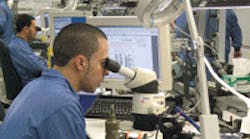Military contractor Raytheon Co. embarked on a strategic sourcing initiative last year to streamline commodities procurement across all of the company's businesses.
That's an ambitious plan considering the company has six different business units contributing to overall revenues of $25 billion in 2010. The directive came from Chairman and CEO William Swanson, who asked the company's continuous-improvement leaders to examine ways to procure materials in a common fashion, says Michael Hoeffler, vice president, Raytheon's evaluation team.
The evaluation team comprises about a dozen people who evaluate more than 100 of the company's 8,000-plus programs annually and help those lines execute more efficiently. This latest effort is an attempt to drive improved supply chain visibility in strategic and tactical areas, Hoeffler says.
It's part of Raytheon's ongoing continuous-improvement efforts as the company looks for ways to strengthen revenues while the government seeks defense budget cuts. When the company announced its year-end results in January, Swanson noted Raytheon's focus on productivity initiatives driven by Six Sigma and operational improvements.
Eventually, the company plans to consolidate its supply base so it's using a smaller number of key suppliers to purchase commodities. With a smaller, more focused supply base, Hoeffler says Raytheon will be able to set expectations on performance and improve enforcement of requirements.
As Raytheon selects key suppliers, the company will share its technology roadmaps with them so all parties are aligned on systems and business plans. Raytheon will provide suppliers with extended inventory visibility by allowing them access to its material requirements planning system. In turn, Raytheon will gain improved visibility to supplier risk issues so it can proactively mitigate potential snags. The company also will increase its use of supplier-managed inventory in the process, Hoeffler says.
In addition to the supply chain initiative, Raytheon continues to build on process-improvement programs that have been critical to past successes. Hoeffler points to the company's Six Sigma program as a major reason for its ability to ramp up production in 2008 when it began supplying the Patriot Air and Missile Defense System to the United Arab Emirates. The company had not made a new system for a number of years and needed to restart production lines at its Andover, Mass., facility, Hoeffler says.
A series of "Six Sigma blitzes" helped make that possible by poring through every aspect of the program and using value-stream maps to highlight how the new business would impact the Andover plant, Hoeffler says.




